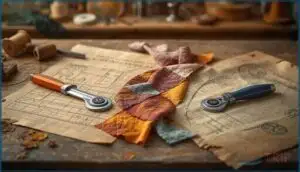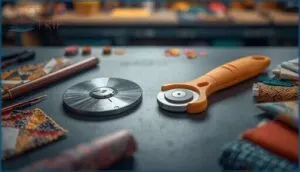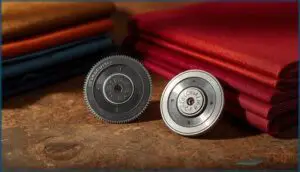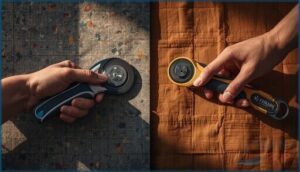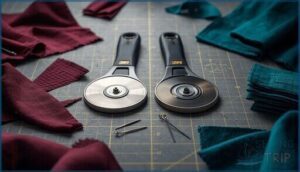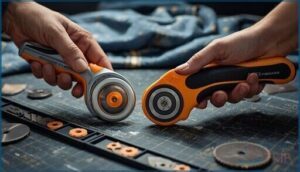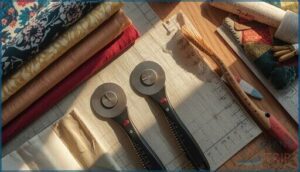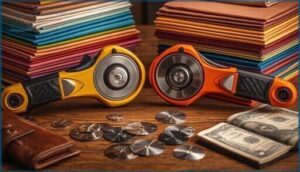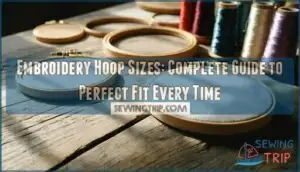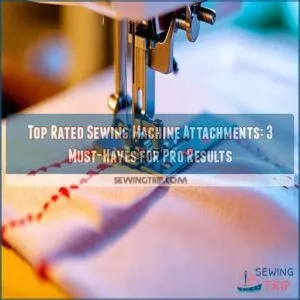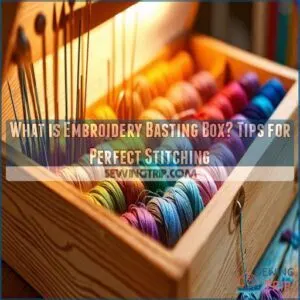This site is supported by our readers. We may earn a commission, at no cost to you, if you purchase through links.

Olfa’s tungsten carbide steel blades stay razor-sharp longer and cut through fabric like butter with less pressure. You’ll change them less often, but they cost more upfront. Fiskars counters with titanium-coated blades and that rock-solid ergonomic grip that won’t cramp your hand during marathon quilting sessions.
Both brands offer 45mm and 60mm options with universal compatibility. The real kicker? Olfa’s quick-change mechanism versus Fiskars’ magnetic blade hub system – each brand has clever tricks up their sleeve.
Table Of Contents
- Key Takeaways
- Olfa Vs Fiskars Rotary Cutters Compared
- Blade Quality and Performance
- Ergonomic Design and Comfort
- Blade Size and Cutting Versatility
- Safety Features and Blade Replacement
- Efficiency for Quilting and Sewing
- Price and Value for Money
- User Reviews and Recommendations
- Top Rotary Cutters and Blades to Buy
- Frequently Asked Questions (FAQs)
- Conclusion
Key Takeaways
- You’ll get sharper, longer-lasting cuts with Olfa’s tungsten carbide steel blades – they stay razor-sharp through more projects and require less pressure, though they cost more upfront than Fiskars’ standard steel blades.
- Fiskars wins for comfort during marathon cutting sessions – their ergonomic grip and lighter weight reduce hand fatigue, making them ideal if you’re quilting for hours at a time.
- Both brands offer 45mm and 60mm options with universal blade compatibility – you can mix and match blades between brands as long as they’re the same size, giving you flexibility when shopping for replacements.
- Your cutting needs determine the winner – choose Olfa if you prioritize precision and blade longevity for thick layers, or pick Fiskars if you value comfort and affordability for general fabric work.
Olfa Vs Fiskars Rotary Cutters Compared
You’ll find clear differences when you compare these two leading rotary cutter brands side by side.
Both Olfa and Fiskars offer unique advantages that can make or break your cutting experience, depending on your specific crafting needs.
Brand History and Reputation
Since 1956, OLFA has carved its Brand Origins through pioneering blade technology. Founded in Osaka, Japan by Yoshio Okada, OLFA invented the world’s first snap-off blade cutter. Meanwhile, Fiskars traces back to 1649 as one of the oldest businesses in the western world, starting as Finnish ironworks. These Rotary Cutter Brands showcase distinct Brand Evolution paths.
From pioneering snap-off blades to centuries of Finnish craftsmanship, two industry giants shape every quilter’s cutting experience
Both companies maintain strong Customer Loyalty through quality manufacturing.
| Factor | OLFA | Fiskars |
|---|---|---|
| Founded | 1956 Japan | 1649 Finland |
| Market Presence | Cutting tools | Multi-category |
| Global Recognition | 60+ countries | 375+ years legacy |
Core Differences and Similarities
Now you’re looking at the heart of these brands’ design philosophy. OLFA rotary cutters target precision crafters with their tungsten carbide steel material composition, while Fiskars rotary cutters prioritize comfort through their Finnish engineering. Your intended use matters—OLFA’s brand identity focuses on professionals, whereas Fiskars’ target audience includes beginners.
| Feature | OLFA | Fiskars |
|---|---|---|
| Philosophy | Precision-first | Comfort-focused |
| Material | Tungsten carbide | Finnish steel |
Blade Quality and Performance
You’ll notice the biggest difference between Olfa and Fiskars when you start cutting through thick fabric stacks. Olfa’s tungsten carbide steel blades stay sharp longer than Fiskars’ standard steel, but both brands cut cleanly when you maintain them properly.
Olfa Blades
Olfa blades stand out with their tungsten carbide steel construction. You’ll find these blades stay sharp longer than most competitors. The blade material cuts through multiple fabric layers without dulling quickly.
Olfa’s sharpening methods involve professional services or replacement. Store your blades in protective cases to prevent damage. Dispose of dull blades safely in blade disposal containers.
Blade compatibility works across most Olfa rotary cutters, making replacements simple. Olfa’s blades are known for being sharper and easier to change than Fiskars.
Fiskars Blades
When you’re comparing blade quality, Fiskars brings premium steel construction to the table. Their titanium coating delivers three times the hardness of regular steel, making these blades a cut above the competition. The lightweight design makes it easy to handle.
Here’s what sets Fiskars blades apart:
- Premium steel with titanium coating – cuts through 12 layers of quilting cotton effortlessly
- Magnetic blade hub system – makes blade disposal and replacement safer than ever
- Ambidextrous design – perfect blade compatibility for both right and left-handed users
You’ll find these blades maintain their sharpness longer, requiring less pressure and reducing hand fatigue during extended cutting sessions.
Blade Longevity
Two blade materials determine how long your rotary cutter lasts. Olfa blades use tungsten carbide steel that stays sharp longer between replacements. Fiskars blades are standard steel that dulls faster but costs less.
Maintaining rotary blade sharpness is essential for peak performance. Cutting pressure, fabric type, and blade storage affect blade sharpness. Proper sharpening methods extend both brands’ blade quality substantially.
Ergonomic Design and Comfort
When you’re cutting fabric for hours, your hand cramps and your wrist aches if you’re using the wrong rotary cutter.
Both Olfa and Fiskars design their grips differently, so you’ll want to know which one fits your grip and won’t leave you reaching for aspirin after a long quilting session.
Handle Shape and Grip
Looking for the perfect rotary cutter means considering how it feels in your hand during long cutting sessions. Handle design directly impacts your comfort and control.
Olfa’s ergonomic grip features a contoured grip that fits naturally in your palm, reducing hand fatigue. Fiskars offers ambidextrous grips with textured materials for a secure grip. Both brands prioritize grip ergonomics, but handle materials and grip size vary between models.
Consider purchasing an Olfa ergonomic handle for ideal comfort.
Weight and Balance
Weight matters more than you’d think when precision cutting fabric for hours. OLFA cutters feel lighter in your hand, reducing hand strain during extended quilting sessions. Their balanced design keeps the ergonomic handle stable against fabric, giving you better fabric control. Some users may want to check the Olfa cutter’s weight for ideal comfort.
Fiskars models weigh slightly more but offer rock-solid cutter stability for precise cuts through thick materials.
User Fatigue
When you’re cutting fabric for hours, hand strain becomes your biggest enemy. Olfa’s ergonomic design with soft grip holders reduces fatigue prevention during prolonged use better than Fiskars.
The cutter weight distribution in Olfa models keeps your wrist comfortable, while Fiskars’ heavier build can cause grip comfort issues after extended sessions.
Blade Size and Cutting Versatility
You’ll find that blade size directly affects what projects you can tackle with your rotary cutter. Both Olfa and Fiskars offer 45mm and 60mm options, with larger blades cutting through more fabric layers while smaller ones handle detailed work better.
45mm Vs 60mm Cutters
Choosing between 45mm and 60mm cutters depends on your projects. The 45mm OLFA and Fiskars models work great for small projects and curve cutting, requiring less blade pressure on thinner fabric thickness.
The 60mm versions handle thicker materials better but feel heavier. Your user preference matters most in this rotary cutter comparison.
Specialty Blade Options
Both brands offer impressive specialty options beyond standard straight cuts. OLFA’s specialty blades include pinking blades, wave blades, scallop edges, and perforated blades for 45mm and 60mm cutters. Fiskars matches with similar decorative edge options.
These specialty materials work great for finishing fabric edges, scrapbooking projects, and creative quilting. OLFA blades usually use tungsten steel for longer-lasting sharpness, while Fiskars focuses on precision-ground stainless steel. For example, OLFA’s blades are made from high-quality tungsten steel to guarantee durability.
Blade replacement stays simple across both brands.
Cutting Multiple Layers
Both OLFA rotary cutters and Fiskars rotary cutters handle cutting multiple layers of fabric well, but they differ in blade pressure control. OLFA’s tungsten carbide blades maintain consistent cut depth through six to eight fabric layers without excessive pressure.
Fiskars requires slightly more downward force but prevents fabric shift better on most mat surfaces during layered fabric cutting operations.
Safety Features and Blade Replacement
You’ll want to check how well each brand protects you from those razor-sharp blades and how easy it’s to swap them out when they get dull.
Both Olfa and Fiskars offer different approaches to keeping your fingers safe while making blade changes quick and painless.
Safety Latches and Covers
Blade safety starts with proper latch mechanisms that prevent accidental activation during storage. Both brands feature safety locks that keep blades retracted when not in use.
Olfa’s blade cover clicks securely into place, while Fiskars uses a sliding safety latch system. These blade guards are essential for child safety and pet prevention in craft rooms.
For additional safety, consider options with rounded tips.
Ease of Blade Change
When you’re ready to change the blades, OLFA rotary cutters offer exceptional Blade Change Speed through their quick-change mechanism. Simply slide out the old blade without tool requirements.
Fiskars rotary cutters require more User Dexterity due to their Mechanism Complexity involving multiple parts.
Both brands handle Blade Disposal safely, but Olfa blades swap faster.
Interchangeability of Blades
When you’re juggling between brands, blade compatibility becomes a real difference-maker for buying blades without brand exclusivity. Fiskars blades will work with an Olfa rotary cutter as long as the blade size matches. Consider these compatibility factors:
- Universal Blades – Most 45mm and 60mm blades fit both Olfa and Fiskars cutters
- Blade Size Comparison – Match diameter precisely for proper fit
- Customization Options – Mix brands based on your cutting needs
- Adapter Use – Check center hole design before swapping
Interchangeable options give you flexibility when shopping for replacement blades.
Efficiency for Quilting and Sewing
When you’re cutting through multiple fabric layers for your next quilt or sewing project, you need a rotary cutter that won’t slow you down or make wobbly cuts.
Both Olfa and Fiskars cutters handle fabric efficiently, but they differ in how smoothly they glide through cotton, wool, and synthetic materials.
Cutting Accuracy
When cutting fabric, accuracy matters more than you’d think. You’ll find both OLFA rotary cutters and Fiskars rotary cutters deliver clean straight line cuts, though each has strengths. OLFA excels at curve cutting thanks to its blade design, while Fiskars offers superior fabric stability during long cuts. Pattern matching requires measurement precision—something both brands handle well with quality rotary cutter blades.
| Feature | OLFA | Fiskars |
|---|---|---|
| Straight Line Cuts | Excellent | Excellent |
| Curve Cutting | Exceptional | Good |
| Pattern Matching | Very Good | Excellent |
Speed and Control
Speed matters when you’re rushing projects, but control keeps your cuts clean. OLFA rotary cutters offer exceptional fabric glide with their ergonomic design, while Fiskars provides excellent curve control through precision handling.
- Cutting Pace – OLFA maintains consistent speed through multiple fabric layers
- Solid Grip – Fiskars’ textured handle prevents slipping during fast cuts
- Rotary Cutter Efficiency – Both brands balance speed with accuracy effectively
- Ergonomic design reduces hand strain during extended cutting sessions
Performance on Different Fabrics
Different fabrics challenge both Olfa and Fiskars differently. Fabric type impact varies substantially – cotton responds smoothly, while cutting leather demands more pressure. Delicate fabrics often face material fraying issues when blade sharpness decreases.
Olfa excels cutting through multiple layers of fabric, whereas Fiskars performs consistently across varied materials. Understanding how to manage fabric grain effectively ensures better quilt block shape.
Ultimately, user skill influence determines success with either brand.
Price and Value for Money
When you’re shopping for rotary cutters, your wallet feels the difference between Olfa and Fiskars pretty quickly. Initial purchase prices vary, but the real test comes when you factor in blade replacement costs and how long each cutter actually lasts through your projects.
Cost Comparison
Price comparison reveals key differences between these brands. Olfa rotary cutters are generally more expensive than Fiskars regarding Initial Cost. However, you’ll find varied pricing across their product lines.
Blade Replacement costs matter substantially over time. Both brands offer competitive rotary cutter blades, but Accessory Costs differ. Olfa blades usually cost slightly more upfront. Fiskars cutters often feature lower entry-level pricing.
Long-Term Savings depend on usage frequency and maintenance habits. Overall Value combines cutting performance with price considerations for smart purchasing decisions.
Durability and Replacement Costs
When you’re thinking long-term, Olfa blades are more expensive upfront but they’re made with tough, long-lasting materials that can stand up to repeated use. The blade material includes tungsten carbide steel for better handle durability.
You’ll replace the blades less often with Olfa, which cuts your replacement frequency and long-term expenses. Fiskars cutters cost less initially but their blades need to be replaced frequently because they dull quickly.
Brand reliability matters here – Olfa blades might cost more per replacement, but you’ll spend less overall when you factor in how often you need new blades.
User Reviews and Recommendations
You’ll find real user feedback from quilters, sewists, and crafters who’ve tested both brands in their workshops. These honest reviews reveal which cutter performs better for specific tasks and help you choose the right tool for your projects.
Quilting Community Feedback
Quilting community insights reveal strong brand loyalty patterns when discussing Olfa versus Fiskars cutters. Most quilters favor the Olfa rotary cutter for its exceptional cutter longevity and project success rates.
Community feedback highlights better cutting accuracy through multiple fabric layers. While Fiskars offers decent performance, experienced quilters consistently recommend Olfa for serious quilting preferences and long-term reliability.
Apparel Sewing Experiences
Apparel sewing demands precision for garment construction and pattern adjustments. Many sewists find the Olfa rotary cutter excels with fabric choices ranging from lightweight silks to heavy denims. Its sharp blade treats seam finishes cleanly, reducing fraying.
However, some report Fiskars works better for curved pattern pieces and fit issues requiring detailed cutting around armholes and necklines. Both brands shine in apparel sewing applications.
Scrapbooking and Crafting Insights
Crafters love both brands for different reasons. Paper enthusiasts prefer Olfa cutter sharpness for Crafting Precision, while mixed-media artists choose Fiskars durability.
Here’s what Project Ideas demand:
- Intricate paper cuts need Beginner Tips for Cutter Maintenance
- Material Variety requires flexible blade options
- Delicate materials benefit from controlled pressure
Both handle scrapbooking beautifully with proper technique.
Top Rotary Cutters and Blades to Buy
You need the right tools to make clean, precise cuts through multiple fabric layers.
These five top-rated rotary cutters and replacement blades offer the best combination of sharpness, comfort, and durability for your quilting and sewing projects.
1. OLFA 60mm Ergonomic Rotary Fabric Cutter
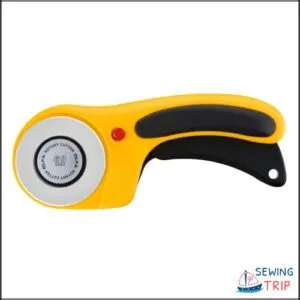
First on our list, the OLFA 60mm Ergonomic Rotary Cutter stands out with its squeeze-trigger handle and anti-slip rubber grip. The ergonomic design reduces hand fatigue during long quilting sessions. You’ll cut through 12 layers of cotton fabric in one pass thanks to the tungsten steel blade, which delivers twice the cutting life of standard blades.
With a 4.6-star rating from over 7,400 reviews, this cutter is a reliable choice. The dual-action safety lock ensures protection, while the ambidextrous design works for everyone. It’s a key point to note that ergonomic grips can improve user experience.
Best For: Quilters and crafters who need to cut through multiple fabric layers while minimizing hand strain during extended projects.
- Cuts up to 12 layers of cotton fabric in one pass with tungsten steel blade that lasts twice as long as standard blades
- Ergonomic squeeze-trigger design with anti-slip grip reduces hand and wrist fatigue during long cutting sessions
- Dual-action safety lock and self-retracting blade provide enhanced protection against accidental cuts
- Higher price point compared to basic rotary cutters, though durability may offset initial cost
- Some users report receiving dull blades or needing adjustment period to master the squeeze-trigger technique
- Contains chemicals (DEHP) that may pose health risks according to California Proposition 65 warnings
2. Fiskars Rotary Cutter 60mm Titanium Blade
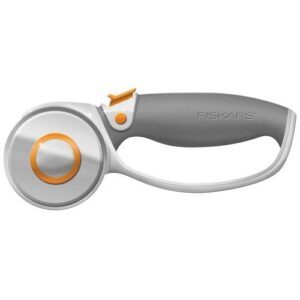
The titanium-coated blade cuts like a hot knife through butter, slicing through multiple fabric layers with outstanding precision. You’ll appreciate the ergonomic curved handle that reduces hand fatigue during marathon quilting sessions.
The sliding button mechanism locks securely for safety while providing quick blade access. This 60mm powerhouse tackles thick batting, denim, and canvas effortlessly, though some users find the plastic components less sturdy than premium alternatives.
The lifetime warranty and easy blade replacement system make it a solid investment for serious crafters.
Best For: Quilters and crafters who frequently cut through thick materials and multiple fabric layers, especially those with hand strength concerns who need an ergonomic tool.
- Titanium-coated 60mm blade cuts cleanly through thick batting, multiple fabric layers, and tough materials like denim and canvas
- Ergonomic curved handle with SoftGrip reduces hand fatigue during extended cutting sessions
- Safety sliding button and lifetime warranty provide security and long-term value
- Plastic components feel less durable compared to premium rotary cutters in the same price range
- Extremely sharp blade requires careful handling and may be challenging for delicate, intricate cuts
- Performance drops when cutting at maximum thickness capacity (12-16 layers)
3. Fiskars 45mm Rotary Cutter for Fabric
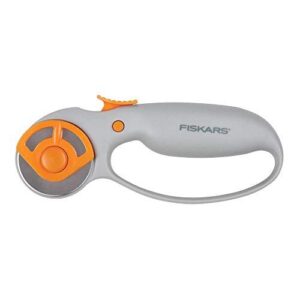
With precision cutting as your goal, the Fiskars 45mm rotary cutter delivers solid performance for fabric work. The curved loop handle fits naturally in your hand, reducing strain during long quilting sessions.
The sliding button mechanism extends and retracts the blade smoothly for safe storage. This cutter accommodates multiple fabric layers well, though you might notice occasional skipping on tricky materials.
The premium steel blade stays sharp reasonably long, but replacement blades are readily available when needed.
Best For: Quilters, seamstresses, and crafters who need precise cuts through multiple fabric layers with comfortable handling.
- Curved loop handle provides natural grip and reduces hand fatigue during extended use
- Premium steel blade with titanium coating cuts cleanly through multiple fabric layers
- Sliding button safety mechanism makes blade extension and retraction simple and secure
- May skip cuts on certain tricky fabrics, requiring consistent blade maintenance
- Blade dulls over time and needs regular replacement for optimal performance
- Higher price point compared to basic entry-level rotary cutters
4. Lhedon 45mm Rotary Cutter Blades
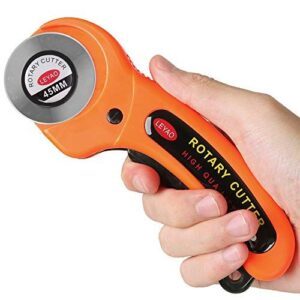
Budget-conscious quilters often overlook Lhedon 45mm blades, but they pack surprising punch. These stainless steel blades slice through multiple fabric layers with minimal pressure, making your cutting sessions less tiring. You’ll get clean cuts on everything from cotton to denim.
The titanium coating extends blade life substantially—expect around three blades per year with regular quilting. While some users report construction issues, the value proposition remains strong.
These universal blades fit most major rotary cutters, including Olfa and Fiskars models, making them perfect backup options.
Best For: Budget-conscious quilters and crafters who need reliable cutting performance without premium pricing.
- Sharp titanium-coated blades cut through multiple fabric layers with minimal pressure
- Universal 45mm size fits most major rotary cutter brands like Olfa and Fiskars
- Extended blade life averages around 3 replacements per year with regular use
- Some users report construction quality issues with parts falling off or blade rubbing
- May require additional pressure or modifications for cutting very thick materials
- Sharpness and durability can be inconsistent compared to premium brand alternatives
5. DEWALT 12 Inch Sliding Miter Saw
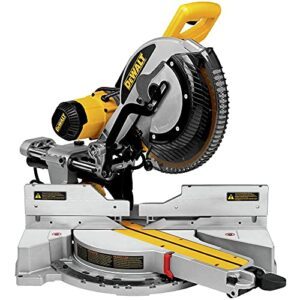
Hold on—this powerhouse doesn’t belong in a rotary cutter roundup. The DEWALT 12-inch sliding miter saw cuts through lumber and trim with surgical precision, not fabric.
Its 15-amp motor delivers 3,800 RPM, while dual steel rails guarantee smooth sliding action. You’ll cross-cut boards up to 13.875 inches wide with XPS LED positioning for shadow-line accuracy.
At 57-69 pounds, it’s built for workshops, not sewing rooms.
Best For: Professional contractors, serious woodworkers, and DIY enthusiasts who need precise cuts on dimensional lumber, trim, and molding in a workshop setting.
- Exceptional cutting capacity handles up to 2×16 lumber at 90° with smooth dual-rail sliding action
- XPS LED positioning system creates precise shadow cutlines without requiring calibration
- Heavy-duty 15-amp motor delivers consistent 3,800 RPM power for demanding cuts through hardwoods
- Heavy 57-69 pound weight makes it impractical for portable jobsite use without a rolling stand
- No included laser guide light, requiring separate accessory purchase for enhanced visibility
- Some plastic components may compromise long-term durability under heavy professional use
Frequently Asked Questions (FAQs)
Are Olfa rotary cutters more expensive than Fiskars cutters?
Yes, you’ll usually find Olfa cutters cost more than Fiskars. An 18mm Olfa runs about $10, while a similar Fiskars costs around $ The higher price reflects Olfa’s premium materials.
Which brand offers sharper blades, Olfa or Fiskars?
You’ll find Olfa blades usually stay sharper longer thanks to their hardened tungsten carbide steel construction. They’re sharpened on both sides, which extends their cutting life compared to standard blades.
Which brand is better for quilting, Olfa or Fiskars?
Olfa takes the lead for quilting thanks to its hardened tungsten carbide steel blades that stay sharper longer. You’ll make cleaner cuts through multiple fabric layers with less effort and blade replacements.
Can you interchange blades between Olfa and Fiskars rotary cutters?
Like mixing paint colors, blade compatibility isn’t always flawless. You can interchange blades between brands if they’re the same size, but some users notice increased hub wear when mixing brands.
Can rotary cutters work on leather materials?
Standard rotary cutters struggle with leather since it’s thick and tough. You’ll need a heavy-duty cutter with a sharp blade and firm pressure.
Consider specialized leather cutting tools for better results.
How do you properly store rotary cutters?
Store your rotary cutter with the blade locked or retracted. Keep it in a dedicated drawer, toolbox, or case away from children.
Don’t toss it loosely in craft bins where the blade might get damaged or cause accidents.
Are replacement blades universally compatible between brands?
Brand-swapping brings benefits – you’re not bound by blade brands. Blades are blades, and you can use any brand of rotary blade as long as it’s the same size.
Most 45mm blades fit across different brands like puzzle pieces.
What cutting mats work best with each?
You’ll want self-healing cutting mats for both brands. Any quality mat works—Olfa, Fiskars, or Dahle all perform well. Choose based on your project size, not your cutter brand.
Do rotary cutters require special sharpening tools?
Imagine accidentally cutting your finger with a dull blade that skipped. You don’t need special tools – most rotary cutters can be sharpened with dedicated sharpeners like TrueSharp or simple aluminum foil.
Conclusion
Choosing between an Olfa rotary cutter and Fiskars comes down to your priorities. Olfa delivers exceptional blade sharpness and precision cutting, while Fiskars excels in comfort and affordability.
Both brands offer reliable 45mm and 60mm options with universal blade compatibility. If you’re cutting thick layers frequently, go with Olfa’s tungsten carbide blades. For extended quilting sessions, Fiskars’ ergonomic design prevents hand fatigue.
Your specific needs determine the winner in this rotary cutter showdown.
- https://www.walmart.com/reviews/product/15407966
- https://sewyoursoul.com/fiskars-45mm-rotary-cutter-review/
- https://richardcastle.net/olfa-vs-fiskars-cutting-mat/
- https://www.reddit.com/r/quilting/comments/1dbco5x/best_rotary_cutter/
- https://olfa.com/products/copy-of-45mm-rty-2-c-quick-change-rotary-cutter-aqua?bvstate=pg%3A2%2Fct%3Ar

